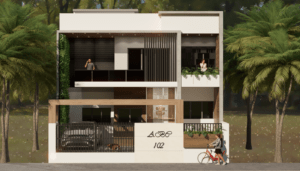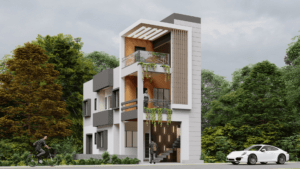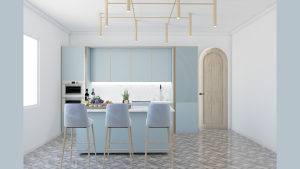Building your dream home doesn’t have to cost a fortune. With the right planning, smart decisions, and expert help, you can create a beautiful custom home on a budget without cutting corners on quality or comfort. In this blog, we’ll walk you through simple, practical steps to keep your costs low while getting a home that’s truly yours.
1. Set a Realistic Budget
Before you start building, you need to know exactly how much you can afford to spend. A clear budget will help you make smart decisions, avoid overspending, and complete your home without unnecessary stress.
How to do it:
Divide your budget into key components:
Land purchase
Construction (labor + materials)
Architectural design
Permits and legal paperwork
Utilities (water, electricity, drainage setup)
Interior finishes
Pro Tip: Always set aside at least 10% as a buffer for unexpected costs like price hikes or small design changes. Also, decide your non-negotiables early (like the number of bedrooms or a spacious kitchen) so you can spend more on essentials and save on the rest.
2. Choose the Right Plot
The plot you choose has a huge impact on your total construction cost. Some land plots look cheaper upfront but come with hidden expenses like soil testing, leveling, and difficult access.
What to look for:
A flat, rectangular plot is ideal easier and cheaper to build on.
Ensure basic utilities (water, power, drainage) are already available.
Good road access means smoother transport of materials and labor.
Pro Tip: Try to pick a plot that aligns with Vastu principles if that’s important to you. If it’s not perfect, a smart architect can tweak the layout to make it more Vastu-friendly without major cost impact.
3. Work with a Budget-Friendly Architect
Hiring an architect may seem like an added expense, but the right architect can actually help you save money in the long run. They design with efficiency in mind and ensure you get the most out of your space.
How an architect helps:
Designs a space-saving layout that avoids material waste.
Recommends cost-effective building techniques and materials.
Plans your home to meet current and future needs—avoiding redesign costs later.
Pro Tip: Choose an architect who offers custom home plans instead of pre-made ones. These are tailored to your lifestyle, budget, and plot conditions, making every square foot count.
4. Go for a Simple Home Design
The simpler your home’s structure, the cheaper it is to build. Fancy shapes, unusual corners, or complex roofs all increase costs due to more labor and material use.
What to do:
Choose a straightforward floor plan rectangular or square layouts are efficient.
Avoid too many walls, cutouts, and levels inside the home.
Stick to a single-pitch or flat roof unless aesthetics demand more.
Pro Tip: A compact, open-plan layout with fewer walls is not only cheaper to build but also looks more spacious and modern.
5. Use Cost-Effective Materials
The type of materials you choose will heavily influence your total cost. While high-end finishes can be tempting, there are many affordable materials that offer good performance and appearance.
Smart material choices:
Use local materials to reduce transportation costs.
Consider fly ash bricks, precast panels, or cement boards as alternatives.
Choose basic flooring tiles in bedrooms and premium ones in main areas only.
Pro Tip: Mix and match! Use budget-friendly materials in less visible areas and invest in one or two standout features like a main door or kitchen counter to elevate the look.
6. Build in Phases (If Needed)
You don’t need to complete everything at once. If your budget is tight, building in phases allows you to focus on the essentials now and add more later.
How to phase your build:
Build the ground floor first, with space or structure planned for an upper floor.
Leave non-essential areas like terrace room, second kitchen, or luxury interiors for a later stage.
Pro Tip: Tell your architect from the beginning if you plan to expand in the future. This ensures the foundation and layout can support future construction without major changes.
7. Avoid Changes Mid-Way
Making changes once construction has started is one of the fastest ways to go over budget. Every design change usually means extra materials, labor, and time.
How to stay on track:
Finalize your floor plan, materials, and elevations before starting.
Get approvals and sign-offs on everything from room sizes to tile designs.
Pro Tip: Take time in the planning stage. It’s better to spend an extra week finalizing than paying extra during construction.
8. Track Every Expense
When building a house, small expenses can pile up fast. Many people lose track and go over budget simply because they didn’t monitor spending regularly.
How to manage it:
Use a spreadsheet or free app to record every purchase.
Set weekly or monthly limits and compare your actual spend to the planned budget.
Pro Tip: Review your expense sheet weekly with your contractor or project manager to catch issues early.
9. Save on Interiors
Interiors can take up a big part of your budget especially if you go for luxury finishes and designer fittings. Focus on functional and essential elements first, and leave upgrades for later when you have more funds.
What to prioritize:
Good flooring, basic lighting, and sturdy plumbing.
Functional kitchen and bathroom fixtures.
Painting with basic finishes (you can add texture or designer paint later).
Pro Tip: Avoid getting everything “perfect” in one go. Simple and neat interiors can still look elegant and you can always personalize over time.
Conclusion
Building a custom home on a budget is 100% possible it just needs careful planning and the right guidance. Don’t rush the process. With expert support, even a modest budget can lead to a home that reflects your lifestyle and dreams.









